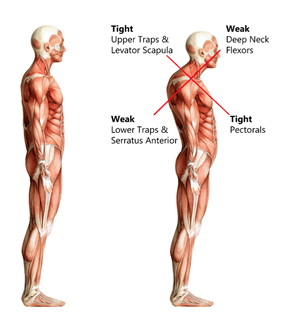Upper crossed syndrome refers to a particular configuration of overlapping overactive and under-active muscle groups in the neck, chest, and shoulders. Typically, poor posture causes the syndrome, including the forward head posture, which occurs when people use electronic devices, read, and drive. Those with upper crossed syndrome usually have the same or similar set of postural irregularities that people may describe as slouching. Many different stretching and strengthening exercises exist that usually offer relief for symptoms of upper crossed syndrome.
Fast facts on upper crossed syndromeCommon causes include a hunched over posture, often an effect of repetitive tasks, such as computer use and office work.Symptoms include neck and back stiffness or aches.Exercises are the main treatment and can help strengthen the weakened muscles of the syndrome.It is not usually serious, but chronic issues of pain and damage to the muscles may mean treatment is usually wise.
With upper crossed syndrome the muscles of the shoulders, neck, and chest have become deformed.
Specifically, the back muscles of the neck and shoulders (upper trapezius, and levator scapula) become extremely overactive and strained. The muscles in the front of the chest (the major and minor pectoralis muscles) become shortened and tight. As a result of these overactive muscles, the surrounding counter muscles become underused and weakened. In upper crossed syndrome, this causes weak muscles in the front of the neck (cervical flexor muscles) and in the lower shoulders (rhomboid and lower trapezius muscles). The condition gets its name from the “x” shape that develops when regions of overactive and under-active muscles overlap.
Poor posture can be a cause of upper crossed syndrome.
Different movements can cause upper crossed syndrome, but most cases develop through poor posture, specifically sitting or standing with the head forward for prolonged periods. Activities that promote this postural position include:computer and laptop usedrivingwatching TVcellphone browsing, texting, app, or game usereadingbikingIn some cases, injury or congenital disabilities may also contribute to the development or creation of the condition.
Symptoms
Common characteristics of upper crossed syndrome include:the head is consistently or often in a forward positioninward curvature in the portion of the spine containing the neck (increased cervical lordosis)outward curvature in the part of the spine that includes the upper back, shoulders, and chest (increased thoracic kyphosis)elevated, protracted, or rounded shoulders, where the muscles are in a continuous state of being pulled or stretched forwardthe visible portion of the shoulder blade sits out instead of laying flat (scapula winging)The deformed muscles associated with upper cross syndrome put stress on the surrounding muscles, tendons, bones, and joints, causing most people develop symptoms that include:headacheneck painstrain in the back of the neck and often a weakness in the frontchest pain and tightnesspain in the upper back, especially the shoulderssore shoulder bladespain in the jawstirednessdifficulty sitting, reading, and watching TVdriving for more than a short period because of pain or muscle tightness or sorenessrestricted range of motion in the neck or shouldersnumbness, tingling, and pain in the upper armspain and reduced range of motion in the ribslower back painExercises
The best way to treat upper crossed syndrome is through exercise and postural changes. Though some people may feel a lot of discomfort when stretching, it is important that they attempt some form of gentle exercise as restricting activity can cause stiffness and soreness.
People must ensure they warm up their tissues before exercising, either with gradual, gentle motions or by having a warm bath or shower. Begin all exercises gently and build up slowly.
Prevention
The best way to prevent and treat upper crossed syndrome is to avoid activities that require stretching the head forward for extended periods of time.
Other tips for preventing upper crossed syndrome include:limiting time spent watching TV, reading, using laptops and computers, or drivingtaking breaks every 15-20 minutes while sitting or engaging in problem activitiesgetting enough cardiovascular exercise, ideally 30 minutes daily from low-impact activities, such as walking or swimmingbeing aware of motions, movements, or activities that worsen symptoms and avoiding them for as long as discomfort continuesdoing stretches that target sore muscles of the back neck, shoulders, and chestdoing strengthening exercises to target weakened muscles in the upper front neck and lower shouldersmaking sure the steering wheel, book, TV, or computer screen is sitting at eye levelusing a lumbar roll in chairsusing a headset for long telephone calls or transcribingusing a single pillow that retains its shape
Correcting or practicing proper posture is also an important part of avoiding and treating upper crossed syndrome.

